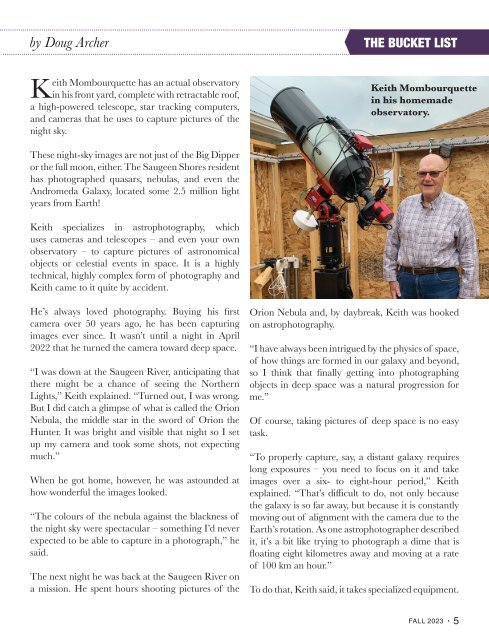Grey-Bruce Boomers Fall 2023
You also want an ePaper? Increase the reach of your titles
YUMPU automatically turns print PDFs into web optimized ePapers that Google loves.
y Doug Archer<br />
Keith Mombourquette has an actual observatory<br />
in his front yard, complete with retractable roof,<br />
a high-powered telescope, star tracking computers,<br />
and cameras that he uses to capture pictures of the<br />
night sky.<br />
THE BUCKET LIST<br />
Keith Mombourquette<br />
in his homemade<br />
observatory.<br />
These night-sky images are not just of the Big Dipper<br />
or the full moon, either. The Saugeen Shores resident<br />
has photographed quasars, nebulas, and even the<br />
Andromeda Galaxy, located some 2.5 million light<br />
years from Earth!<br />
Keith specializes in astrophotography, which<br />
uses cameras and telescopes – and even your own<br />
observatory – to capture pictures of astronomical<br />
objects or celestial events in space. It is a highly<br />
technical, highly complex form of photography and<br />
Keith came to it quite by accident.<br />
He’s always loved photography. Buying his first<br />
camera over 50 years ago, he has been capturing<br />
images ever since. It wasn’t until a night in April<br />
2022 that he turned the camera toward deep space.<br />
“I was down at the Saugeen River, anticipating that<br />
there might be a chance of seeing the Northern<br />
Lights,” Keith explained. “Turned out, I was wrong.<br />
But I did catch a glimpse of what is called the Orion<br />
Nebula, the middle star in the sword of Orion the<br />
Hunter. It was bright and visible that night so I set<br />
up my camera and took some shots, not expecting<br />
much.”<br />
When he got home, however, he was astounded at<br />
how wonderful the images looked.<br />
“The colours of the nebula against the blackness of<br />
the night sky were spectacular – something I’d never<br />
expected to be able to capture in a photograph,” he<br />
said.<br />
The next night he was back at the Saugeen River on<br />
a mission. He spent hours shooting pictures of the<br />
Orion Nebula and, by daybreak, Keith was hooked<br />
on astrophotography.<br />
“I have always been intrigued by the physics of space,<br />
of how things are formed in our galaxy and beyond,<br />
so I think that finally getting into photographing<br />
objects in deep space was a natural progression for<br />
me.”<br />
Of course, taking pictures of deep space is no easy<br />
task.<br />
“To properly capture, say, a distant galaxy requires<br />
long exposures – you need to focus on it and take<br />
images over a six- to eight-hour period,” Keith<br />
explained. “That’s difficult to do, not only because<br />
the galaxy is so far away, but because it is constantly<br />
moving out of alignment with the camera due to the<br />
Earth’s rotation. As one astrophotographer described<br />
it, it’s a bit like trying to photograph a dime that is<br />
floating eight kilometres away and moving at a rate<br />
of 100 km an hour.”<br />
To do that, Keith said, it takes specialized equipment.<br />
FALL <strong>2023</strong> • 5
















